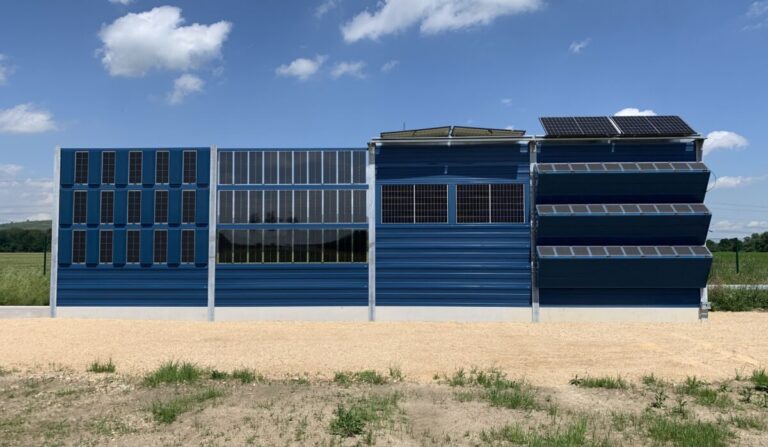A German research team is testing new module concepts in practice that can be integrated into noise barriers along roads or railways. The hope is that some of the designs will emerge as cost-effective, energy-generating solutions for use in newly constructed sound barriers, renovations or extension projects.
Researchers in Germany Fraunhofer Institute for Solar Energy Systems ISE (Fraunhofer ISE) are testing new module concepts in practice for integration into noise barriers along roads or railways. The hope is that some of the designs will emerge as cost-effective, energy-generating solutions for use in newly constructed noise barriers, in retrofits or addition projects.
The research, called PVwins, started in 2020 and has now reached the open-air field testing phase. The research team developed five different integrated PV solutions for use in sound-absorbing walls, typically located in populated areas with busy roads and railway lines. They examined the design, prototyping, production, economic potential and marketability.
The collaborating partners include R. Kohlhauer GmbH, specialized in the supply of soundproof walls and noise barriers, IGRA Power GmbH, an engineering and PV specialist, the German utility company Energiegenossenschaft Inn-Salzach, the German Ministry of Roads Bundesanstalt für Strassenwesen , and the national railway company. research organization Deutsches Zentrum für Schienenverkehrsforschung des Eisenbahn Bundesamt, together with the Swiss manufacturer of PV modules Megasol Energie.
Some of the solutions resulting from the collaboration enable sound walls made only with PV panels without the need for additional sound-absorbing elements, while others are suitable for retrofitting existing infrastructure, or for use as an addition. Below is a summary of each PV solution with references to the photo above (from left to rightT).
- A combination solution where modules have two independent cell strings to harvest light from the back of the sound absorber and the front of the same wall (all the way to the left)
- Transparent micro-perforated acoustic absorbers on the front of the module
- Conventional PV modules installed vertically on a barrier facing away from the road
- Conventional PV panels installed via brackets on top of the noise barriers, one is oriented east/west and the other is oriented south
- New retrofit cassettes with road-facing acoustic absorbers and angled PV panels (to the far right)
Project leader Jacob Forster explained that the noise-reducing modules are larger and more robust than conventional panels, measuring 3.96 m, with 6 mm glass panels and a stable frame supplied by Kohlhauer. The other modules mounted on top of the walls and vertically are standard modules with glass back plate and aluminum frames. “Here the motivation was not in the use of special modules, but in cheap components,” Forster said pv magazineadding that a range of technologies can be used such as passivated emitter rear cell (PERC), heterojunction or Tunnel oxide passivated contact (TOPCon).
Forster noted that the team was “positively surprised” that the acoustic insulation of the heavy glass modules was in the same range, or even slightly better, than commercially available sound-absorbing elements from partner company R. Kohlhauer GmbH.
A document describing the module and system designs: “Photovoltaic noise barriers as energy-generating infrastructure: functional overview of five solutions (pdf)”, was presented at the 40th European Conference and Exhibition on Solar Photovoltaics.
The potential for these types of vertical PV applications is significant, according to the latest research from the European Commission’s Joint Research Center (JRC). Fraunhofer ISE is also participating in another integrated PV study, known as MASS-IPV.
This content is copyrighted and may not be reused. If you would like to collaborate with us and reuse some of our content, please contact: editors@pv-magazine.com.


